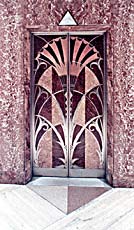Two years after the Exposition held in Paris, the New York’ department store, Macy’s, held a six day Exposition of Art in Trade to emphasise the connection between art and commerce. It was indicative of this struggle to justify mass-produced, machine-made products as art pieces. That Art in Trade took place in a retail space is significant. Public perception in America at this time did not class machine made objects as art, so the act of exhibiting such objects in a retail space alongside sculpture and paintings went some way toward altering this perception.
While the exposition served to commercialise art, simultaneously emphasising the aesthetic in machine-made products, the 1934 MoMA exhibition entitled Machine Art had an approach which effectively turned a museum space into a department store. This effectively expressed the extent to which the modern home had become dependant on these machines. It championed the manufacturing power of America, in its presentation of American made and American consumed products, ultimately boosting sales of such goods and strengthening relationships between artists and manufacturers [3].
The role of the machine fulfilled an economic, social and artistic function through exhibition in the modern American institution of the department store and trend setting MoMa. It conveyed the idea that abstract beauty could be found in the relationship between form and function in the machine or machine made object, coming to characterise capitalism in modern America and contributing to the iconic status of the brand logo that we have today.

New York’s Chrysler building embodies, in its architecture and luxurious interior decoration, the importance of associations between mass production and art. Completed in 1930, the building was seen at the time by architecture critics to be an enormous advertisement for Chrysler. At the top of the building, sculptures modelled on the Chrysler cars’ features such as hubcaps and car wheels can today be seen as a study in the beauty of the machine. The entrance lobby ceiling is covered by a huge mural entitled Energy, Result, Workmanship and Transportation, by Edward Turnbull. The mural depicts the building and workers on its construction, and praises the modern technology that facilitated the buildings creation. The lobby is decorated with marble, onyx, travertine and steel art deco compositions. The famous elevator doors are embossed with an abstract sunburst design, which echoes the motif of the stainless steel crescents of the buildings spire, and have been said to indicate the influence of ancient Egyptian designs on the Art Deco movement [Fig. 4]. The whole effect of the lobby is to dazzle, emphasising the marvels which the machine age had made possible to realise.
In the growing popularity of machine art, distinctions between high culture and everyday products began to collapse. The beauty of high art was easily understood by the public and as the Chrysler building exemplifies, high culture was used to add prestige to mass-produced objects, most notable in the lavish interior decorations of the lobby. While the architecture of the building may have been criticised at the time for its ornamentation and conscious reference to the physical features of the brand, the intention was that they would become symbols of recognition in the beauty of the products themselves.
Design in advertising throughout the first half of the twentieth century was hugely influenced by the machine aesthetic. The British advertising artist, Ashley Havinden, exhibited this particularly well in the period from 1926. The design company he belonged to, Crawfords, were responsible for producing advertising campaigns for the Chrysler car, newly introduced to England, giving him the opportunity to innovate in this field of design. To approach this new account, Havinden travelled to Germany to investigate the typographical foundries, an endeavour which resulted in his firm appointing him art director to organise the design work for the Berlin Chrysler account [4].This experience placed Havinden in closer contact with European modernist styles which became an important influence in his work.